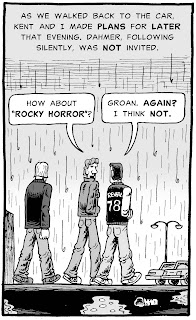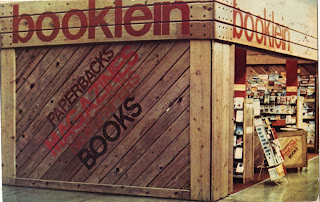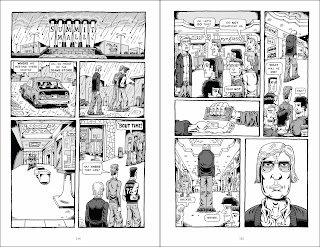I'm probably persona non grata at my old high school, as you can well imagine. Especially with all the worldwide press this book has received. The names Dahmer and Revere High School are even more cemented together, thanks to me. Sorry about that. But why stop there? Dahmer and I also both attended Ohio State University, although not at the same time. Might as well cheese off the suits at that institution, too, no?
Jeff attended OSU in Fall Quarter 1978, starting in mid-September. Ohio State had an open admissions policy at the time, meaning any resident of the state was admitted without question. A high school diploma was all that was needed. It was either sink or swim and Freshman dropout rates were embarrassingly high, but it was an admirable, populist system. Me, I excelled at Ohio State, a school I wouldn't even be accepted at today. By the time I was done, I had earned a full scholarship. Today my photo hangs in two buildings and the Derf Collection is in the famous Ohio State Cartoon Museum, the world's top institution of comix and cartoon art. Dahmer's experience at OSU, however, was altogether different.
His Dad, Lionel, forced him to enroll, as he writes in his memoir A Father's Story. Jeff displayed very little interest in college, or in anything, after high school. He loafed about all day at home and drank. So great was his consumption that Lionel, for the first time, became aware of it. Even then, Lionel didn't realize the shocking amount of alcohol his son was consuming on a daily basis. His admonishments fell on deaf ears. Jeff languished in the house, staring out the large windows at the wooded hillside. Inside his head, a film loop of murder, necrophilia and butchery played non-stop. A horror show he couldn't switch off. Jeff's terrible secret, of course, was the reason for his drunken state. He had already killed, and had sex with and butchered his first victim's corpse. In fact, the remains of Steven Hicks were hidden in a drainage pipe mere feet from the driveway at the Dahmer house! Lionel hadn't the slightest hint of the thoughts and all-consuming compulsions that were gurgling in his son's brain. But he was alarmed at Jeff's total lack of purpose or interest in his future. Lionel was a driven man, a research chemist, and his distant and disinterested son perplexed and frustrated him. Jeff had always been an inscrutable mystery to Lionel. Now he was a fast growing source of aggravation.
Come September, after a summer of idleness, Lionel forced Jeff to pack his things and Lionel and his new live-in girlfriend drove him to Columbus. Jeff had a room in the dreaded Morrill Tower, one of two recently constructed high-rise dorms on the far west side of campus. They were only a few years old in 1978, but already had the rep of being hellholes. Students were housed in "pods," which were as awful as they sound. A pod consisted of a central living area with four cramped bedrooms off it, each with four residents and two bunk beds. The 16 "podmates" shared a bathroom and a living area. Roommate squabbles were common. Freshman who were unlucky enough to be assigned to one of the Towers scrambled to get transferred to other dorms.
![]() |
| Morrill Tower (foreground) in 1977. |
![]() |
| Floorplan of a Morrill Tower "pod" |
To make it even worse, the Towers were completely isolated from the rest of the campus. It was a long hike across the open intramural athletic fields and past hulking Ohio Stadium to the main campus. It is even farther to High Street, the mile-long strip of bars, eateries and shops that borders the eastern edge of campus and is the heart of student life.
Dahmer had no interest in college. He slept until afternoon, ate a solitary lunch at the dorm cafeteria, walked to High Street bars or carry-outs in the late afternoon, got shitfaced, and staggered back to his dorm in the wee hours of the morning, collapsed in bed, and slept until the next afternoon when he rose to do it all over again. Every single day. Week after week. There were 20 or so high school classmates who also went to Ohio State, but the only one who ever saw Dahmer was Penny Smith (name changed) who came across Jeff passed out cold on the sidewalk outside a HIgh Street bar. She was unable to revive him out of his drunken stupor and left him there, sprawled among the filth and litter, and puddles of sick and urine.
Occasionally, probably out of boredom or fear of his father's anger, he attended a class or two. Often he would sneak booze in with him in a pop can, much in the way he had hidden booze in a styrofoam coffee cup as he lurched through the halls of Revere High School. Jeff's roommates regarded him as a freak. He was ignored, and within weeks, disinterest turned to open dislike. They grew increasingly alarmed by Dahmer's drunken state and bizarre manner. And for good reason! I can tell you firsthand that Jeff was completely unlikeable by the end of high school. And that was before he committed his first unspeakable, depraved crime! Now he was an inhuman wretch, haunted by the monstrous acts he had committed on poor Steven Hicks and living in blind terror that someone would discover the decomposing remains in the drainage pipe. A pathetic parasite, wriggling through the rotting rubble of his life while sucking on a bottle of booze.
I cannot imagine being trapped in a dorm room with this guy! Can you picture his roommates' confusion and shock over those first few days together as Dahmer's everyday dysfunctional behavior came sharply into focus? I saw how Dahmer drank, gulping down booze. It made my skin crawl. And these guys had to sleep in the same, small room with him! Dahmer decorated his area in the bedroom with a small picture of his dog, Frisky, a snakeskin he found in the woods around his house (one of his many dead animal treasures and they only one "normal" enough to keep with him at college) and, mostly, with empty booze bottles. This was a fairly common trophy in the party-hearty Seventies, but the collection grew so fast and his consumption was so obviously excessive, far beyond even the most stoned-out loser, it quickly became creepy.
Tensions grew. One of his roommates moved out when a space in another bedroom opened. The others complained to a dorm official about Dahmer, but were told to "work it out." As long as it didn't come to blows, this was the common "solution" back then to roommate troubles. (I myself was having horrible roommate problems at my dorm at the Pittsburgh Art Institute). Things began disappearing in the pod. Dahmer was immediately suspected of the thefts. His podmates called campus police and Jeff was detained and questioned in November 1978 about the theft of a radio, watch, and $100 cash from the room during a party but, as would become his m.o., Jeff admitted nothing and didn't crack under questioning. No charges were filed. His podmates started locking their doors and hiding their things. They threatened Jeff, but he responded only with the blank stare that was his trademark.
As the quarter progressed and the weather turned colder and wetter, Dahmer became less willing to go out and make the long trek across the wind-whipped tundra. He bought cases of beer and bottles of wine and whiskey and consuming them alone in his dorm room bunk until he passed out. Booze wasn’t cheap and Dahmer quickly ran through the weekly allowance his father sent him to live on. To fund his alcohol purchases, Jeff sold plasma and blood at a blood bank on South High Street for $10 a pop. It was a joking cliche for cash-strapped students to sell plasma, but Dahmer became such a frequent visitor that his name was put on a list with junkies and winos whose visits were restricted for their health’s sake.
![]() |
| Ad for the Plasma Center from the student newspaper, 1978 |
The quarter ended in early December. Dahmer returned home to Bath. When his grades arrived a week later, he had failed almost every one of his courses. His overall GPA was 0.45. His dad was aghast and furious. Jeff responded with a shrug and a silent stare at the floor as Lionel chewed him out and told him he would not be returning to Oho State. Lionel writes that Jeff seemed "relieved" at the news.
The first week of January, when school resumed, Lionel drove down to Morrill Tower to collect his son's things. Jeff did not accompany him. When he met Jeff's roommates, they described in detail his son's daily regimen of alcohol. Lionel was absolutely dumbfounded. For the first time, Jeff's shocking and disturbing behavior emerged from the shadows. At that point, Jeff had been binge drinking... for TWO AND A HALF YEARS!
I started at Ohio State nine months later, after dropping out of art school and working as a garbageman in our hometown. Dahmer was long gone by that point, having joined the army under his father's insistence and shipped off to a base in Germany. I ran into many old classmates during my four years on campus. Dahmer's name never came up.
Dahmer's brief time at Ohio State is now part of campus lore.




























